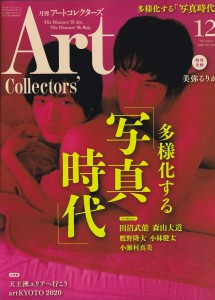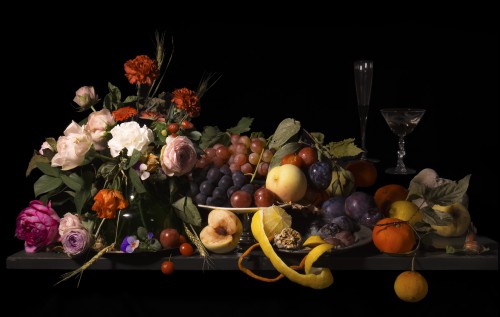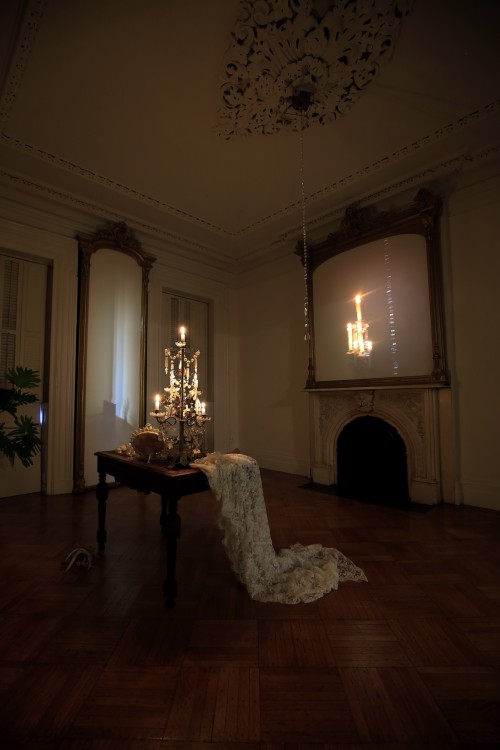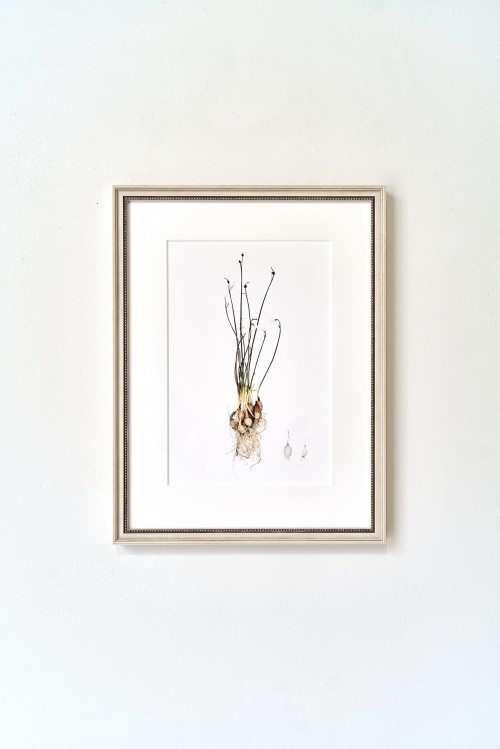
Art Collectors'
Magazine
SHUFUNOTOMO Co., Ltd.
Art Collectors’
December Issue / p. 44-46
December 25, 2020
The Diversifying "Age of Photography"
Part 4
Expression as Painting and as Photography
Publisher: SHUFUNOTOMO Co., Ltd. / Interviewer: Kazumi Nishimura (Editorial.)
At first glance, it seems like a seventeenth-century realistic still life. In fact, however, it is a work of dozens of photographs taken over a period of four months. We asked Kosemura, who skillfully combines ancient painting composition with photo processing and video technology to explore her own method of photographic expression, about her production methods and her artistic commitment.
─ You studied oil painting at the graduate school of Tokyo University of the Arts, so why did you decide to go into photography and film?
Actually, I didn't enter the oil painting department to study painting. I wanted to do contemporary art from the beginning, so nowadays, I would go to the Department of Intermedia Art or the Department of New Media at the university. But in my time, the only two options for students pursuing contemporary art were oil painting or sculpture.
For graduate school, I chose the mural painting major, which had a larger space to create an installation, even within the oil painting department. The two years of my master's degree that I spent in that course were mostly free, and I wanted to get to know videos and film, which I had begun to do a bit better, so I started going to the Image Forum Institute of Moving Image in Aoyama.
─ How did you encounter video art?
When I was a student, my friends took pictures for production notes, but I used a video camera. I was more interested in a state of motion rather than one that was stationary, a state of gradual change, such as the way the grass swayed in the wind. The Institute of Moving Images, which was developed by the foundation of Japanese experimental film following in the footsteps of Shuji Terayama (1935-83, Japanese avant-garde poet, dramatist, writer, film director, and photographer), is attended by students as well as the general public. When I was talking to my classmates, I realized that painting, especially oil painting, which I thought was normal for me as a painter, was a very special thing to do in a general sense. So, I decided to make a video that could only be made by a person with an oil painter's sensibilities. But video at that time was technically inadequate, and the images captured were pale with too little color reproduction. Also, I felt somewhat distant from the video medium. I happened to go to the Institute, which was a rare school at the time that strictly taught film camera technique. The images on film had vivid colors and were very beautiful. Also, because I cut and patched the images by hand, I felt as if I were directly touching the images with my own hands. When I was a student, I used to draw with my fingers because my brushes got in the way when I was concentrating on the painting. Looking back, I think I was trying to get a real sense of the image by painting with my hands. The images and paintings were linked with the visual experiences I had through film production. This is how I created my early video works based on still life paintings.
─ Your early films are seemingly classical still lifes of fruit. I was impressed by the slow withering of the leaves and the decay of the fruit. How did you create it?
Over a period of four months, I took thousands of photos using interval photography with a camera shutter release at regular intervals, and then I connected them together to create the animation. With film, there is a limit to how long it takes to shoot, and digital video quality was poor at the time(in those days). The technique of creating animated pictures from high quality photos replicated the quality and tension of a painting. During the take, I would stay out of the room, no matter what happened to the subject (still-life), except to make sure the system was working properly. I was taking pictures as if I was filming a documentary.
─ The "Banquet" (2018) is not a video, but a single photograph, is that right?
It is based on a painting "Flowers and Still Life" by the 17th century Netherlandish painter Cornelis de Heem. If you look closely at still life paintings of that time, you can see a strange situation where fruits of all four seasons exist at the same time, such as grapes harvested in autumn, strawberries in spring, and peaches in summer. In other words, they were depicted as a composite. In modern day Japan, it takes only four months to have all fruits of the four seasons, including those grown in greenhouses. It can be said that this work symbolizes today's convenient situation. I decided in advance what to put where and which space to leave open, leaving dead or rotten things as they were, and adding new fruits and flowers as they became available. As I do this, I select about 20 parts out of the hundreds of photos I have taken to make one piece.
─ Four months seems to be a long time for production. Why do you spend so much time on one work?
In media art and video, you can't really feel the human touch, but what I'm aiming for in my work is something that shows the warmth of the human hand, like a one-of-a-kind craft or painting, even though the digital work is a reproduction. Modern life is very hectic, for example, the need to react immediately on social networking sites. A single photo/image is also meant to make people think about the importance of being able to face a single photo in front of them and think about something carefully, and notice something unusual in it.
─ What kind of work is "Pendulum" (2016) ?
It is an installation using a 19th century townhouse in New York. I used the two large mirrors in the living room as screens. Synchronized images of the same space (images taken with multiple shooting methods such as panoramic photography, time-lapse photography, etc.) were projected there. In 20 minutes, the video goes from morning to night and then back to morning. Through the images reflected in the mirror, the audience experiences unrealistic situations in the room they are in, and moments when reality suddenly looks like a painting.
─ In your new work, "Anatomical Observation"(2021), the botanical subjects seem to be natural, yet somehow unnatural, giving a peculiar feeling. Could you tell me about the content of this new work?
This is a series of photographs based on botanical art, which began to be painted around the 15th century. Early botanical paintings were done purely as a record, so the basic rule was to draw them at full size. Long plants were too long to fit on paper, so flowers were cut in the middle of the stem and painted next to the roots separately. The rules of composition were completely different from those of oil painting. The painter considers the plant purely as an object, which is interestingly close to the camera's perspective. In this series of photographs, the plants are arranged according to these botanical painting methods, photographed with a camera, and then digitally drawn on the photographs, referring to the way they were painted at the time.
─ What is your vision for your future work ?
I would like to continue my series of botanical paintings as my lifework. The piece shown on the previous page was taken in New York, my other base, where I photographed local plants. Now, I would like to take pictures of Japanese moss, fern, and other plants that are characteristic of Japan. My role model as an artist is Louise Bourgeois (1911-2010). She was an artist I first liked as a high school student. I find it amazing that even though her works are born out of her personal issues, they are so inclusive that the audience can take them as their own. I hope to create works that will help people as individuals to discover "what it means to see things" and "what it means to live" through my own personal perspective.
(October 21, 2020, interview at remote)


